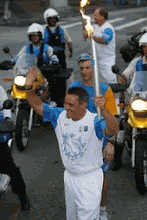Selecting a kayaker to represent the U.S. at the Olympic Games is not a straightforward process. One USA Canoe/Kayak official told me today that their Olympic Team selection criteria is more than 30 type-written pages, which only appears a little strange to a spectator when you see how straightforward flatwater kayaking is. The mano-a-mano, first-to-the-finish nature of the race is pure, rich, and the dominant intensity factor in this beautiful sport. And no race demonstrated this essence on Friday more than the men’s 500 meter single kayak (K1) race.
With a win in this event, two-time Olympian, Rami Zur, would qualify directly to his third Olympic Games this summer in Beijing. Confident, strong, and always looking for a big challenge, I got to know Rami five years ago during a “team-building” outing hosted by the U.S. Olympic Committee (USOC) for Athens Olympic hopefuls. Our group of about 100 athletes went to the Naval Special Warfare Center in San Diego where we would tackle the training/obstacle course used to train and prepare Navy Seals. As our bus pulled closer to the obstacle course, our eyes fixated on a 55-foot wooden frame of ropes dropping out of the sky. I nervously said, “Climbing harnesses to go over those, don’t you think?” To which Rami replied, “No way, my friend.”
As we filed off the bus, the USOC officials, who had not seen the obstacle course in person before this moment, were quickly dissuading athletes from climbing the wall of ropes. But it was too late. Athletes were sprinting towards the wall like kids running to an ice cream truck on a summer afternoon. Leading the pack and smiling ear to ear was Rami. He scaled up the wall like Spiderman, hurled himself over the huge cross-log at the top, and flew down the other side giggling while the most of the other athletes were still sizing up the challenge from the ground on the other side.
It is this kind of can-do spirit that defines an athlete who would likely take the men’s 500 meter K1 Olympic slot on the U.S. Olympic Team. However, that spirit was provided by someone else on Friday.
Morgan House of Gainesville, GA played the role of “challenger” in this event. At 20 years-old, Morgan’s racing conveys wisdom beyond his years and a competitive fire that burns from “inside.” Calm, cool, and confident, Morgan brings something new to the race which is what made his strong surge in the last 100 meters to win here at the Olympic Trials much more interesting. Between Morgan and Rami, we’re treated to two very different styles trying to win the same race.
Which leads us to our un-resolution of this Olympic spot here at the Olympic Trials. By virtue of winning on Friday, Morgan doesn’t take the Olympic spot but he does prolong the Olympic selection until early June when he and Rami will compete in Europe for the start position in Beijing. It’s a “winner take all” situation and over the next six weeks, the emotion of two very different kayakers raising their standards, pushing harder, and going faster will be exciting to watch. But take away the emotion from that process and one element strikingly stands out. The U.S. will field a better kayak racer in Beijing by resolving to resolve later.





